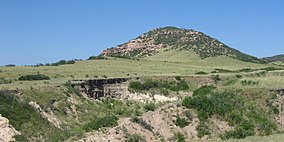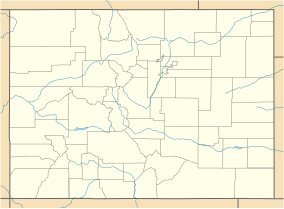| Soapstone Prairie Natural Area | |
|---|---|
 The arroyo surrounding the Lindenmeier archaeological site (Folsom culture) on Soapstone Prairie Natural Area near Fort Collins, Colorado. | |
Map of
Colorado | |
| Location | Larimer County, Colorado, United States |
| Nearest city | Fort Collins |
| Coordinates | 40°58′48″N 105°03′44″W / 40.979898°N 105.062256°W |
| Area | 28 sq mi (73 km2) |
| Established | 2004 |
| Official website | |
Soapstone Prairie Natural Area is a 28-square-mile (73 km2) park and conservation area in northeastern Larimer County, Colorado, United States. The City of Fort Collins purchased the land for Soapstone Prairie Natural Area in 2004, which was opened to the public in 2009. [1]
Ecology
The natural habitat of eastern Colorado was shortgrass prairie. Over the past 150 years much of the land was used for agriculture. Of the 40% of the remaining shortgrass prairie, much of it is degraded and fragmented due to neighboring cities, towns and farms. [2] The area has thriving prairie dog colonies. [3] Almost 60 endangered black-footed ferrets were reintroduced in 2014 whose main source of food is prairie dogs. [4]
The Natural Resources Department of Larimer County recognized that grazing was important for soil, vegetation and overall ecological balance and that Bison were the primary historical grazers before being extirpated. [5] The managers wanted to create a herd that could act as a seed herd that would help establish bison with heritage genetics. [6] Establishing a conservation Herd became a collaborative effort of Larimer County, the City of Fort Collins, the US Department of Agriculture’s Animal and Plant Health Inspection Service, and Colorado State University. [7] Yellowstone genetically valuable bison were introduced in 2015 onto the contiguous lands of Soapstone Prairie Natural Area and Red Mountain Open Space. [8] Ten bison were released into a 1,000-acre fenced site (400 ha). [9] By 2021, the herd grew to about 120 and were grazing on approximately 2,500 fenced acres (1,000 ha) of shortgrass prairie. [6] In cooperation with partner organizations, bison are being sent to Native American tribes where they are important for cultural endeavors and food sovereignty. With these transfers, tribes have been able to start their own herds. Bison have been sent to tribes in Wisconsin, New Mexico, Montana, South Dakota and Minnesota. [10]
Archaeological site
The Lindenmeier site, named for the previous Lindenmeier Ranch, is a Folsom archaeological site on the Soapstone Prairie Natural Area. The site contains the most extensive Folsom culture campsite yet found with an uncorrected averaged radiocarbon date of 10,660±60 B.P., or 8,710 B.C. The site was declared a National Historic Landmark on January 20, 1961. [11]
See also
References
- ^ "Soapstone Prairie Natural Area". City of Fort Collins. 1996–2011. Retrieved September 19, 2011.
-
^
"Trails of Northern Colorado: Exploring Cultural and Natural Heritage". Fort Collins Museum & Discovery Science Center. 2010. Archived from the original on January 6, 2012.
{{ cite web}}: CS1 maint: unfit URL ( link) - ^ McKee, Spencer (February 13, 2023). "Nine 'thought-to-be-extinct' predators released to prey on Colorado's prairie dogs". OutThere Colorado. Retrieved February 13, 2023.
- ^ Meyers, Stephen (October 14, 2015). "Soapstone Prairie offers remote, beautiful experience". The Coloradoan. Retrieved February 16, 2021.
- ^ Boster, Seth (February 15, 2021). "From Colorado prairie, heritage bison slowly returning to native lands". The Gazette (Colorado Springs). Retrieved February 16, 2021.
- ^ a b Lindgren, Annie (April 24, 2022). "CSU and Partners Provide 39 Laramie Foothills Bison to 3 Native Nations". North Forty News. Retrieved August 15, 2022.
- ^ "Laramie Foothills Bison Conservation Herd Project". Colorado State University. Retrieved December 2, 2021.
- ^ Marmaduke, Jacy (November 7, 2015). "Rare bison free to roam in northern Colorado". Durango Herald. Retrieved May 16, 2021.
- ^ Zaffos, Joshua (April 4, 2016). "In bison recovery, scientists start small". High Country News. Retrieved May 16, 2021.
- ^ Spencer, Michael (May 26, 2023). "Bison population, with Yellowstone National Park roots, explodes in Colorado". CBS Colorado. Retrieved July 6, 2023.
- ^ "Lindenmeier Site". National Historic Landmark summary listing. National Park Service. Archived from the original on January 4, 2008. Retrieved October 15, 2007.
External links
| Soapstone Prairie Natural Area | |
|---|---|
 The arroyo surrounding the Lindenmeier archaeological site (Folsom culture) on Soapstone Prairie Natural Area near Fort Collins, Colorado. | |
Map of
Colorado | |
| Location | Larimer County, Colorado, United States |
| Nearest city | Fort Collins |
| Coordinates | 40°58′48″N 105°03′44″W / 40.979898°N 105.062256°W |
| Area | 28 sq mi (73 km2) |
| Established | 2004 |
| Official website | |
Soapstone Prairie Natural Area is a 28-square-mile (73 km2) park and conservation area in northeastern Larimer County, Colorado, United States. The City of Fort Collins purchased the land for Soapstone Prairie Natural Area in 2004, which was opened to the public in 2009. [1]
Ecology
The natural habitat of eastern Colorado was shortgrass prairie. Over the past 150 years much of the land was used for agriculture. Of the 40% of the remaining shortgrass prairie, much of it is degraded and fragmented due to neighboring cities, towns and farms. [2] The area has thriving prairie dog colonies. [3] Almost 60 endangered black-footed ferrets were reintroduced in 2014 whose main source of food is prairie dogs. [4]
The Natural Resources Department of Larimer County recognized that grazing was important for soil, vegetation and overall ecological balance and that Bison were the primary historical grazers before being extirpated. [5] The managers wanted to create a herd that could act as a seed herd that would help establish bison with heritage genetics. [6] Establishing a conservation Herd became a collaborative effort of Larimer County, the City of Fort Collins, the US Department of Agriculture’s Animal and Plant Health Inspection Service, and Colorado State University. [7] Yellowstone genetically valuable bison were introduced in 2015 onto the contiguous lands of Soapstone Prairie Natural Area and Red Mountain Open Space. [8] Ten bison were released into a 1,000-acre fenced site (400 ha). [9] By 2021, the herd grew to about 120 and were grazing on approximately 2,500 fenced acres (1,000 ha) of shortgrass prairie. [6] In cooperation with partner organizations, bison are being sent to Native American tribes where they are important for cultural endeavors and food sovereignty. With these transfers, tribes have been able to start their own herds. Bison have been sent to tribes in Wisconsin, New Mexico, Montana, South Dakota and Minnesota. [10]
Archaeological site
The Lindenmeier site, named for the previous Lindenmeier Ranch, is a Folsom archaeological site on the Soapstone Prairie Natural Area. The site contains the most extensive Folsom culture campsite yet found with an uncorrected averaged radiocarbon date of 10,660±60 B.P., or 8,710 B.C. The site was declared a National Historic Landmark on January 20, 1961. [11]
See also
References
- ^ "Soapstone Prairie Natural Area". City of Fort Collins. 1996–2011. Retrieved September 19, 2011.
-
^
"Trails of Northern Colorado: Exploring Cultural and Natural Heritage". Fort Collins Museum & Discovery Science Center. 2010. Archived from the original on January 6, 2012.
{{ cite web}}: CS1 maint: unfit URL ( link) - ^ McKee, Spencer (February 13, 2023). "Nine 'thought-to-be-extinct' predators released to prey on Colorado's prairie dogs". OutThere Colorado. Retrieved February 13, 2023.
- ^ Meyers, Stephen (October 14, 2015). "Soapstone Prairie offers remote, beautiful experience". The Coloradoan. Retrieved February 16, 2021.
- ^ Boster, Seth (February 15, 2021). "From Colorado prairie, heritage bison slowly returning to native lands". The Gazette (Colorado Springs). Retrieved February 16, 2021.
- ^ a b Lindgren, Annie (April 24, 2022). "CSU and Partners Provide 39 Laramie Foothills Bison to 3 Native Nations". North Forty News. Retrieved August 15, 2022.
- ^ "Laramie Foothills Bison Conservation Herd Project". Colorado State University. Retrieved December 2, 2021.
- ^ Marmaduke, Jacy (November 7, 2015). "Rare bison free to roam in northern Colorado". Durango Herald. Retrieved May 16, 2021.
- ^ Zaffos, Joshua (April 4, 2016). "In bison recovery, scientists start small". High Country News. Retrieved May 16, 2021.
- ^ Spencer, Michael (May 26, 2023). "Bison population, with Yellowstone National Park roots, explodes in Colorado". CBS Colorado. Retrieved July 6, 2023.
- ^ "Lindenmeier Site". National Historic Landmark summary listing. National Park Service. Archived from the original on January 4, 2008. Retrieved October 15, 2007.
